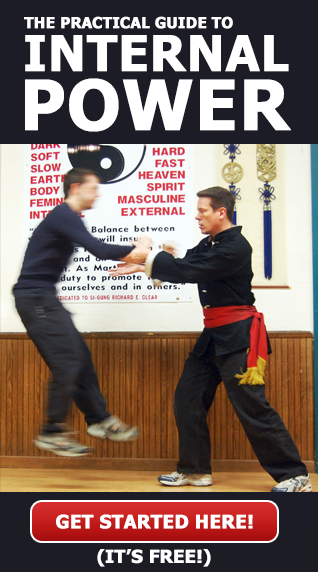Peng, Lu, Ji and An are considered to be primary physical jin energies in Tai Chi Chuan.
Each of them has a directional aspect to them- but are more complex than “left” or “down”
But before we can get on to those 4- we have to start with the foundation-
Sung Jin
Tai Chi is one of the more deadly self defense methods out there.
Softness is one of the key reasons Tai Chi is so deadly.
Soft is power.
Any tension in the body cuts off power.
The softer you are the more power you can get to the end of your strike.
Softness lets you take a hit without any damage.
The softer you are the more you can feel.
When you are soft enough to feel tension in the opponent you can direct the force or your strikes to their tension.
When you are soft enough to feel their heart or kidneys then you can attack their heart or kidneys with your strikes.
If you’d like some in-depth instruction on Sung, I have a whole section dedicated to it in my FREE Practical Guide To Internal Power.

This guide will take you step by step through how to develop many of the Internal Power skills you’ve always heard of- and maybe even seen- but were never taught.
Peng Jin
Peng Jin translated into English as Ward Off is classically considered to be the first posturally based Tai Chi energy taught to beginners.
I was first exposed to Peng Jin in the late 1970’s.
By the mid 1980’s I was fairly capable with the immovable aspect of Peng Jin.
In more recent years I have become much more aware of other aspects of the skill.
I believe that perhaps the best way to tackle the subject of Peng Jin is to simply list a number of the qualities you need.
Some of these qualities seem like they would be mutually exclusive to others-
but they don’t contradict as much as they might seem at first glance.
For instance, some of the Tai Chi classics talk about Peng being hard and soft at the same time. All of these qualities I have listed are present at the same time for real peng.
That is just part of the duality (Yin and Yang) of Tai Chi.
Qualities Necessary for Peng Jing
- Wu Chi Alignment Principles – Particularly the head held up by a string with the rest of the body hanging
- Ground Path
- Sung (relaxed but not collapsed)
- Rooted & Heavy
- Alive, springy elastic and pliable compression ability in the soft tissue of the body giving the body the buoyant feel of a boat or ball on water.
- Ligament and tendon strength
- The “straight in the curve” body bows and spirals.
- Round Ball expansiveness in all directions at the same time that makes it so that your body space cannot be entered and at the same time deflects anything/one trying to enter off around the outer circle of the ball.
- Sensitivity to feel where the incoming force is coming from and neutralize it as well as draw power off of it.
- A healthy mix of physical and mental eventually becoming much more mental with only a bare minimum of physical necessary. Relax everything so that you use only as much as you need and no extra. Expand with your mind so that your mind creates the expression.
Lu Jin
Lu Rollback is the second physical jin traditionally learned in Tai Chi training.
In America Lu Rollback is a bit more well known as a result of having been publicly stated to be Chen Man Ching’s favorite move / action of Tai Chi.
Essentially Lu Rollback jin generally refers to the idea of getting out of the way of an incoming force simply by turning in a way so that the force is diverted out and / or away from you.
Moving the arm(s) in a circle that diverts an incoming push or strike is the most common way that most folks have seen this action performed.
Cloud Hands is a very Lu Rollback oriented Tai Chi move.
Lu jin is also classically noted for the practitioner receiving and collecting energy that they can then return to the attacker.
All of the first 4 primary Tai Chi jins can be performed with the arms and with other body parts as well including the torso.
The first 4 primary Tai Chi jins can also be performed in large, medium and small frame manners.
I will cite an example of performing Lu Rollback with the torso using a large frame movement.
Person A puts their hand on Person B chest and pushes straight in.
Person B simply circles their entire torso so that Person A’s push does not go in and Person A stumbles if they keep trying to push as they are now pushing against / into air.
The push is effectively neutralized by Person B’s movement.
An example of performing an internal small frame Lu Rollback movement is that Person A pushes into Person B’s chest and Person B receives the Push and routes it through their body so that it comes back out into Person A’s hand and pushes or hits them sending them back or breaking the wrist or arm.
At a high level there is no physical movement that can be seen on the part of Person B.
This is a skill that will come relatively quickly to anyone who completes our Internal Skill through Internal Push Hands video(s) that will be coming out soon.
Ji Jin
Ji translates as Press and tends to refer to the idea of pressing or pushing in with pressure in a way that causes two points of contact to meet in one spot inside the recipient.
So, two vectors of force that are directed and intended to meet in the same place.
There are two major ways to this happens-
The most commonly shown is to fortify your own body by pointing many of these lines of force all through the same point to multiply the difficulty others would have in moving or stopping you.
And while this is technically correct- it’s just a small piece of the pie.
Ji Jin, as an expression, is very powerful when used on someone else’s body instead of your own.
This is one of the simplest to grasp methods to Fa Jin- and one of the trickier shapes to neutralize on the receiving end.
Essentially, you are converting force from two (or more…) different directions into a surprising third direction that carries all the force of each line-
often with explosive results!
An Jin
An (Pronounced like the word “on”) translates as Push and tends to be a downward and then an upward action to help uproot the opponent.
An Push jin refers to the idea that the force travels through the recipient moving or coming out the other side of the intended target.
In simpler terms- you can think of it like hydraulic force.
By rapidly squashing all your weight into one area, you are displacing the other person-
Often in the exact opposite direction they might expect.
An is a tricky interaction- but it is also tricky to do.
Like all of the other Jins I have mentioned- it gets better and better with skill and practice.
But unlike the other Jins here- there’s no way to just “partially do it” or “miss it by a bit.”
Either you execute An correctly, or you end up failing to do much at all.
As a result, it’s easy to struggle with it early on.
How These Jins Relate To One Another
The 5 Gateway Energies are expressed in each and every movement of a proper Tai Chi form, whether you realize it or not.
And while each of the styles (and teachers) differ on how they express it, it’s a hallmark of Internal skill.
If you’re looking for more, and you want to know where to go from here,
The Practical Guide to Internal Power was designed to be more than just education-
It’s a training tool that will help push you to DO the proper work needed to develop the skills you’re looking for.
If you want results, you can get them here:

Thank you all,
And remember-
Keep training!
-Sifu Clear

Speak Your Mind